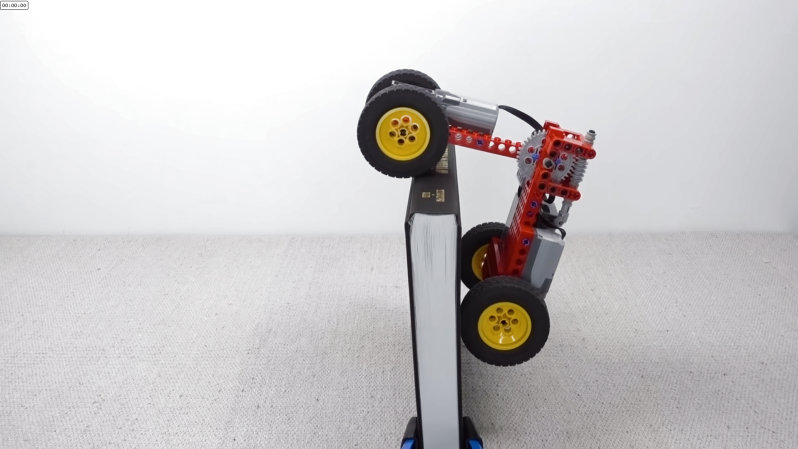When we want to prototype a rover, we’ve developed a tendency to immediately reach for the 3D printer and Arduino or Raspberry Pi. It’s easy to forget the prototyping tool many of us grew up using: LEGO. The [Brick Experiment Channel] has not forgotten, and in the video after the break demonstrates how he used Lego Technic components to prototype an impressive little obstacle climbing robot.
The little Lego rover starts as a simple four-wheeled rover trying to climb on top of a book. Swap in a four-wheel-drive gearbox and grippy tires, and it clears the first obstacle. Add a few books to the stack causes the break-over angle to become an issue, so the rover gets an inverted-V chassis. As the obstacle height increases, batteries are moved around for better weight distribution, but the real improvement comes when an actuating middle joint is added, turning it into a wheeled inchworm. Clearing overhangs suspended beams, and gaps are all just a matter of finding the right technique.
Thanks to Lego’s modularity, all this is possible in an hour or two where a 3D printer and CAD might have stretched it into days. This robot does have the limitation of not being able to turn. Conventional car steering or Mecanum wheels are two options, but how would you do it?
The [Brick Experiment Channel] knows a thing or two about building Lego robots, even for stealing keys.
















I’ve been itching to do something with Tri-Star wheels for a while…. probably since seeing Damnation Alley LOL
They are very cool things, though I think they would have enormous trouble traversing objects as large as seen here unless you have controlled rotation and drive (plus the extra hands to control it all).
I’ve been wanting to try and build a three wheeler with them (just because that is a lot of threes really) with dump truck style bend in the middle steering for a while. Seems like a decent platform for a great many mobile projects being more capable of stairs and rough ground than many options at the same scale.
Right. I was also thinking of keeping the weight at the rear as much as possible so it could maybe stand up on it’s hind axle. Even maybe stretch when it’s got it’s cg between the two downward wheels.
If you reallllly wanted to push the number of controls though for RC, you can try for dual axis thumb sticks then a slider on the back of the box for each index and ring finger.
Or if you don’t need portability, just RC hook up a flight simulator HOTAS with pedals – lots of extra axis there. With it using all of your limbs it also means more readily available buttons too.
Thank you for not misspelling it “Legos”.
I wonder if giving it a Segway self-balancing mode would get it over some of those obstacles easier?
You’d need to add some non-lego parts for the sensors and on-board logic.
Pretty sure the NXT Lego mindstorm stuff had sufficiently fast processing, and it defiantly has an accelerometer sensor available – all real Lego parts. If they can really do that job in this situation is less clear, but self balancing in general can (and has) been done with all Lego parts.
I don’t know if that self-balancing would get it over the obstacles easier, but it certainly would be faster on some of them. I think the transitions between self-balancing and folding around the obstacle might actually be harder to get right, and less reliable than this crawl up it method. Great Idea though.